Shortage of Skilled Labour and Construction Professionals
Info: 22400 words (90 pages) Dissertation
Published: 18th Oct 2021
Tagged: ConstructionEmployment
Abstract
“An investigation into the shortage of skilled labour and construction professionals due to economic changes impacting the UK construction industry since the 2008 recession.”
This investigation in to the shortage of skilled labour and construction professionals within the UK construction industry was developed to discover the varies opinions of the current professionals within the industry. The idea for this investigation came from first-hand experience whilst trying to recruit skilled labour on my placement year. Therefore, further investigation needed to take place to get an understanding on why there is a skill shortage within the industry.
Firstly, research was focused around the skill shortage and the effects in which the 2008-2009 recession had on the industry further research identified that the recession had a continuous effect until 2012. Nevertheless, the findings showed that the UK construction industry employs 324,000 fewer workers in 2016 than it did in 2008 according to Martin (2016). Therefore, suggesting that the industry hasn’t fully recovered from the effects of the recession. Nevertheless, other impacts were identified which were; aging population, EU migration, government investment, industry image to name a few. Secondly, research focussed around the UK government and UK construction companies to see their impact towards the skill shortage.
The findings shown in chapter 5.0 of this investigation shows that 83% of respondents believe that there is a current skill shortage within the industry. Further findings suggest that construction professionals believe that apprenticeships are the way to help relive the skill gap. These findings have been support by literature throughout chapter 2.0.
Recommendations for easing the skill gap is for the UK government to provide extra support to UK construction companies to help the younger generation get into the industry through apprenticeship schemes.
Abbreviations
AGE Apprenticeship Grant for Employers
CIC Construction Industry Council
CIOB Chartered Institute of Building
CITB Chartered Industry Training Board
ESS Employer Skills Survey
EU European Union
GVA Gross Value Added
QS Quantity Surveyor
UK United Kingdom
1.0 Introduction into the Research
1.1 Personal Reflective Statement
The purpose of this dissertation was identified whilst on industrial placement year, regarding the troubles of obtaining a skilled workforce due to the lack of skilled labour and construction professionals currently in the industry.
1.2 Rationale for the Research
This dissertation analyses the shortage of skilled labour and construction professionals within the UK construction industry, since the 2008 recession. Studying the UK government and construction companies will determine their contribution towards the shortage of skilled labour, through insufficient schemes and policies.
The investigation will involve analysing current schemes offered for individuals by the UK construction companies for skilled labour and construction professionals. Analysis will include studying the causes and effects of the shortage of skilled labour to determine if the construction industry needs to alleviate skilled labour shortage, whilst reviewing the economic changes which could have contributed towards the shortage in skilled labour.
The UK governments education system will also be analysed to consider the policies and schemes to see if they are providing young people with the opportunity to get into the construction industry predominantly through apprenticeships.
1.3 Research Aim
To investigate the shortage of skilled labour and construction professionals in the UK construction industry, and establish to what extent the UK government and construction companies have contributed, through apprenticeships since the 2008 recession.
1.4 Research Objectives
The aim of this research will be supported by using the following objectives:
- To provide an overview of the construction industry whilst referring to the construction industries skill shortage.
- To examine the UK governments apprenticeship schemes implemented for the UK construction industry.
- To analyse the impacts of the 2008 recession within the UK construction industry and its skilled labour workforce.
- To review the issues regarding the aging population within the construction industry and how its contributed towards the skill shortage.
- To establish the potential solutions for overcoming the current skill shortage within the construction industry.
1.5 Outline Structure
Chapter 1.0 of the dissertation indicates the research background and the importance and relevance behind researching the topic area. Within this section, the aims and objectives will be outlined to set the framework for the investigation.
Chapter 2.0 provides an analytical literature review based around the area of study meeting the aims and objectives set out in chapter 1.0. The literature is obtained from secondary resources which will be referenced throughout.
Chapter 3.0 includes the methodology which was used for the research. The chapter evaluates appropriate methods available, whilst providing rationalisation for the chosen methods. The methodology will be linked back to the literature review. Advantages and disadvantages will be indicated along with any limitations for the chosen methods.
Chapter 4.0 contains the results gathered from the primary research carried out around the topic area. Analysing and identifying the findings from the primary data collected from the semi-structured interviews, as well as the questionnaire both methods were sent out to construction professionals.
Chapter 5.0 of this dissertation provides a conclusion based around the literature review and primary data obtained from chapters 2.0 and 4.0. Limitations for the research will be identified along with any recommendations for further research.
1.6 Outline Methodology
Chapter 3.0 of this dissertation contains the methodology section which outlines and identifies the appropriate research methods used to complete this investigation. Bryman (1988) stated a ‘best of both worlds’ method by recommending that qualitative and quantitative approaches ought to be combined. Therefore, for the completion of this investigation both methods have been used to form triangulation by using questionnaires and semi-structured interviews. Primary data obtained from quantitative and qualitative research will be analysed against the secondary research carried out in chapter 2.0. Triangulation method has been used to get an in-depth insight into the way construction professionals see the skill shortage by using selected sampling by only distributing the questionnaires and interviewing industry professional’s full transcripts are shown in the appendices.
2.0 Literature Review
2.1 Rationale for Literature Review
This chapter aims to critically analyse literature that is currently present within the United Kingdom (UK) construction industry linking back to the aims and objectives within chapter one. The literature review will cover an extensive variety of topics related towards the shortage of skilled labour within the UK construction. The report will be based from the 2008 to present to investigate if the UK government or construction companies have contributed towards the shortage or not. The literature review will source information through diverse sources such as: books, journal articles, reports and online publications.
2.2 Skill shortage definition
The definition of a skill shortage is needed in order to analyse the skill shortage in the UK construction industry. The Oxford dictionary defines a skill as the ‘expertness, practised ability, facility in an action or in doing; dexterity or tact’ (Thompson 2000, p964). This is developed further by Lind Frogner as the ability to perform a task to a predefined level of competence’ (Ruiz 2004).
Shortage is defined by the Oxford dictionary as ‘a deficiency; amount lacking’ (Thompson 2000, p948). Shah C and Burke G (2003, p5) defined a shortage as ‘when the demand for workers for a particular occupation is greater than the supply of workers who are qualified, available and willing to work’. This supports the definition provided by the Oxford dictionary, as both describe a shortage as lacking something. When referring to construction it refers to a lack of skilled labour.
Richardson (2007) defines a skill shortage as “a shortage of skills is a source of aggravation to firms and, when acute, is likely to hamper the quality and quantity of their output” (Richardson 2007, p8). This enforces the importance of having a skilled workforce, due to the implications that occur through quality and quantity. Shortages occur when “there are more vacancies with certain skills needs than there are people available with those skills” (Frogner 2002).
2.3 Overview of the Current UK Construction Industry
The UK construction industry is a significant sector for the UK economy; in 2014, it contributed £103 billion in economic output, 6.5% of the total (Rhodes 2015).
In 2008, the UK construction sector the “Gross Value Added (GVA) was almost £81 billion, which accounted for just over six per cent of total UK GVA; making the sector the seventh largest out of 15 broad sectors” (Breuer 2012, p11). The sector accounts for 7.1% per cent of the UK workforce (2.28 million workers) (REF). This indicates that the workforce is too small for the amount of revenue it generates being the seventh largest sector. This indicates that the UK construction industries has the potential to produce a larger gross value if the percentage of workforce increased. Expand / explain.
A report by Zurich (Walker 2015), consisting of two hundred medium sized construction companies found 75% (150) construction companies believed there was a skill shortage within the UK construction industry shown in figure one. 75% believed the skilled labour shortage was not easing, supporting the Chartered Institute of Building (CIOB) report recording that “82% believe a skills shortage exists in the construction industry” (Townsend 2015 p1). This supports the case of a shortage of skilled labour within the industry and that companies within are aware of the shortage however, only 13% of companies are taking on apprenticeships to get individuals into the industry (Wiseman, Roe, Parry 2014).
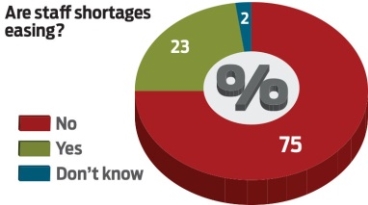
Figure one – Source: Walker, 2015.
2.3.1 Causes of the Shortage of Skill Labour and Construction Professionals
Further research is needed to comprehend whether the UK government and UK construction companies have contributed towards the shortage of skilled labour within the UK.
The CIOB carried out a survey to investigate the shortage of skilled labour and construction professionals, by surveying 1,182 of their members. The findings highlighted the reduction in the amount of apprenticeships starting is worrying, 55% associate this with an upsurge in skill shortages (CIOB 2009). The results by CIOB show that the reduction in apprenticeships offered by the UK government have contributed towards the shortage. However, the survey was only carried out by members of the CIOB therefore, findings cannot be confirmed due to the small percentage of the industry being surveyed.
Furthermore, another cause for the shortage is the negative industry image. Chief construction advisor Peter Hansford stated that change is fundamental in the way the construction industry is perceived by the public. Therefore, linking back to the shortage if the image is perceived by others in a negative manor then recruiting new professionals and labour into the industry is difficult. Hansford also indicated that engaging the younger generation as well as society is the emphasis to change the industry image (Wilkinson 2014).
Whilst investigating further into the skill shortage focusing around apprenticeship schemes the low wages are not attracting the younger generation into the industry resulting in the aging workforce. Therefore, to attract and increase the amount of apprenticeships schemes. However, the UK government have cut rates by 50% for new apprenticeship schemes for 16-18 year olds for a level to framework in construction (Linford 2016). This indicates that the UK government are not providing enough support to prevent a further skill shortage from occurring. Further research suggests that the UK government are however, introducing the apprenticeship levy scheme which comes into effect in spring of 2017 which will be explained in section 2.6.
2.3.2 Issues Affecting the UK Construction Industry
A report by the CIOB recorded that “82% believe a skills shortage exists in the construction industry, a 5% increase from the 2011 survey” (Townsend 2013, p1). The report consisted of 1,346 respondents, with 90% believing that apprenticeships are part of the answer to fixing skill gaps in the construction industry, and “46% thinking that a lack of investment from the industry and government are the biggest threat to the future skills” (Townsend 2013, p1). The findings highlighted the fact that the UK construction industry is suffering from a skill shortage and the government, construction companies and education system need to contribute to an increase in the amount of skilled labour within the industry.
57% of construction companies are currently providing training nonetheless, it is still below the national benchmark for all industries which is 66% set by the Employer Skills Survey of 2013(Wiseman et al., 2014). However,the benchmark is set as a national benchmark for all sectors, not specifically for the construction industry. This makes the above benchmark insufficient as the industry has a wide range of small to large companies. Resulting in small companies not having the funds to provide a wide range of training to their employees. Nevertheless, only “one in seven employers (13%) currently have staff undertaking apprenticeships. This is the same proportion as that reported in 2011” (Wiseman et al., 2014 p6). The Chartered Industry Training Board (CITB) report confirms the original statement that construction companies have contributed to the shortage in skilled labour within the construction industry, as the amount of apprenticeships taken on from 2011 to 2014 has not increased.
2.3.3 Apprenticeship Schemes offered by the UK government and construction companies
In 2015, 9,306 construction apprenticeships were completed, this signifies a 4% drop on 2013’s previously low figure of 9,688. However, it continues deteriorating from a high point set in 2009 when 16,947 apprentices were completed(Blackman 2015). These findings indicate that the government and construction companies are not doing enough to help the shortage of skilled labour. Nevertheless, in 2014 18,493 apprenticeships were started which is 14.8% more than 2013’s figures (Blackman 2015). This is supported by the CIOB 2013 skills report stating that there had been a 7% rise from the skills report findings in 2011. However, this survey carried out by the CIOB surveying 1,346 construction professionals, which shows this is only carried out on a specific range of professionals.
2.4 The 2008-2009 Recession Effect on the Industry
The 2008-2009 recession affected the UK construction industry from 2006 till 2013 according to Rohner (2016). However, this cannot be confirmed as it has only been found from one source. Nevertheless, when looking at figure two it shows that the UK construction industry started to decline in 2004 then fluctuating until dropping below -15% in 2008-2009. Yet, it does not show 2013 so this cannot confirm the above statement from Rohner (2016). Nevertheless, it does show how the construction industry has fluctuated over the past 10 years with the 2008-2009 recession having a destructive influence on the industry.
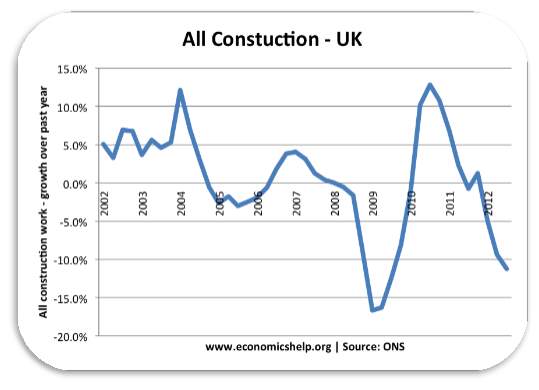
Figure two – Source: Pettinger, 2012.
Figure two highlights the impact of the 2008 recession within the UK construction industry growth, dropping to below -15%. The UK construction industry employs 324,000 fewer workers in 2016 than it did in 2008 according to Martin (2016). Further research indicated that Kollewe (2016), states that the construction industry does employee 324,000 less workers than in 2008. Supporting the indication that the construction industry is still facing a shortage in skilled labour due to figures continuing to remain lower than during the recession in 2008. However, cannot be confirmed due to limited sources. Nevertheless, the findings suggest a lack of input from the UK government as well as UK construction companies. Supporting the previous statement that only “One in seven employers (13%) currently have staff undertaking Apprenticeships. This is the same proportion as that reported in 2011” (Wiseman et al., 2014, p6). Stating that a lack of apprenticeships offered has impacted on these employment figures still being below that recorded in 2008.
2.4.1 Recovering from the recession
In 2011, 45% of employers reported the recession/low demand/an uncertain economy were the main factors that limited growth within the UK construction industry. In 2014, this remained the most significant factor however, only 17%, stated the factors continued to affect their organisation (Wiseman et al., 2014). The findings suggest substantial improvement has occurred regarding economic conditions during this period. However, in 2016, the UK construction industry slipped back into a recession after output fell by 3.6% during March the biggest drop in four years (Allen 2016). This indicates that the UK construction industry is still suffering from the 2008-2009 recession, linking back to the shortage of skilled labour and construction professionals due to the reduction in work.
Therefore, potentially causing a UK recession as the UK construction industry equates to only 6% of the UK economy (Allen, K. 2016). WHY?
2.4.2 The Effects of Brexit on the UK Construction Industry
Construction sites could lose almost 215,000 workers in the event of a ‘hard’ Brexit according to Prior, G. 2016. The research identifies an expected upsurge in skilled labour shortage between 2016 and 2020, equivalent to 14% of the workforce within the UK construction industry (Wilkinson 2016). The UK construction industry has shrunk at its fastest pace since 2009 after the UK voted leave (Sheffield 2016), figure three below shows the extent of the decline in 2016.

Figure three – Source: Rhodes and Wilson (2016).
Brexit will directly affect the construction industry skilled labour. As the UK, has voted to leave the EU it will impact on the availability of labour, as free movement is anticipated to be restricted following the transition period (Wasniowski 2016). As the UK construction industry is already reliant on the EU workforce this could cause an increased rise in the shortage of skilled labour.
2.5 Ageing Population within Construction
Nearly one in five construction workers are estimated to retire in the next 5-10 years therefore, the UK construction industry could possibly be left facing a skill shortage(Bannister 2016).Supported by the CITB which indicates that with the next ten years 400,000 skilled workers will reach retirement age (Stocks 2016). The two statements support the suggestion that the UK construction industry must recruit new individuals into the industry, before the skill shortage upsurges. Nevertheless, due to the limited sources stating the findings that one in five will retire in the next five to ten years this cannot be confirmed.
The findings in figure four indicates the aging population is contributing towards the shortage of skilled labour and construction professionals. The industries workforce going into retirement age is overweighing the entry of the younger generation. Nonetheless, the findings do have their anomalies as the survey was carried out for CIOB members only not the entire industry.
Age Breakdown of the UK Construction Industry, survey carried out by the CIOB.
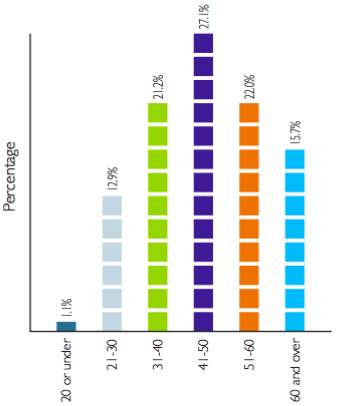
Figure four – Source: CIOB (2009).
2.6 Potential Solutions to ease the Labour Shortage
Potential solutions for the UK construction industry to restore its skilled labour include: attracting new talent, this can be achieved by construction companies offering more apprenticeships and increasing the number of apprentice schemes offered by companies above the 13% offered in 2014. Companies should also aim to reach the “64% benchmark, set out by Employer Skills Survey” (ESS) (Wiseman et al., 2014 PG NO), by offering more training schemes. A £100m construction skill centre planned for London “initially estimates suggest that as many as 3,000 apprenticeships and 1,400 jobs could be created on the back of the skills academy in its first five years” (CITB 2016 PG NO). The scheme will only support the London construction industry, not the whole of the UK resulting in only contributing to providing a limited amount of skilled labour and construction professionals into the construction industry. As the above figures, will not be sufficient to stop the shortage of skilled labour in the foreseeable future.
In 2015, the UK government have introduced a new law by setting a target to generate 3 million apprenticeships by 2020 (Boles 2015).This targetrelies on the support of construction companies to help reduce the shortage of skilled labour within the industry, through the use of employment schemes that will provide training for the new potential workforce. This is support as according to the CIOB the UK government has set suggested they want to provide 3 million apprenticeship starts over the next five years(Townsend 2015). The findings show that the UK government distinguishes that apprenticeships are needed to help regenerate the industry however, the enormous projected figure shows the UK government haven’t done enough up until 2015. However, this target set by the UK government will be beneficial employers fear that the UK governments fixation with creating 3 million apprenticeships over the next five years will mean quality sacrifices in an attempt to enhance figures. Therefore, this would do little in fixing the UK’s skill shortage. Furthermore, the UK government are enforcing large UK employers to pay into the levy. (O’Connor, S. 2015).
Nonetheless, through further research the government construction strategy (GCS) has been established to help restore the construction industry. The focus point set out by this strategy is to reduce the shortage of skilled workers, with the aim to “deliver 20,000 apprenticeships through central government procurement over this Parliament” (Bridges 2016 pg no). The target set out by the GCS will contribute towards the regeneration, yet this will not solve the problem throughout the industry. Furthermore, the UK government are introducing the apprenticeship levy scheme in April 2017. The scheme is aimed at all sizes of construction firms, it will replace all taxpayer funding of apprenticeships. Therefore, construction firms having a payroll of over £3 million must pay a sum of 0.5% if they chose to invest. All firms investing into the levy will then receive an offset allowance of £15,000. However, if the payroll is below £3 million the company will receive the offset allowance to use for investing into apprenticeship schemes (CITB 2017). The apprenticeship levy set out by the UK government is for all UK companies to invest into which will construction companies reduce the skill shortage. Nonetheless, as well as the UK government apprenticeship levy the CITB are also introducing an apprenticeship levy aimed at UK construction companies. As indicated in table onethe employers will invest into apprenticeship schemes and the CITB levy will provide the companies with a grant to support construction companies in recruiting a new workforce (CITB A 2017).
Table one shows how levy funds are shared among micro to large companies to support training.

Table one – Source: CITB, A 2017.
Company sizes per employee for table one; micro companies: 1 to 9 employees, small companies: 10 to 49 employees, medium companies: 50 to 249 employees and large companies: 250+ employees.
These two levy schemes introduced by the UK government and CITB will help ease the shortage however, construction companies need to invest into these schemes for them to have a positive effect on reducing the skill shortage.
Mark Farmer stated that the “UK construction industry needs to find 1 million new workers in the next five years across the whole construction industry” (Sadek 2015 PG NO). Which was explained in the report ‘People and Money’. Linking back to the levy schemes if construction companies are prepared to invest into training a new workforce the target indicated by Mark Farmer should be achievable. Nevertheless, this cannot be confirmed due to being the only report stating this figure. However, the industry does need to recruit at a rapid rate to regenerate the industries workforce at a faster rate than
the contrasting retirement rate.

Figure five (Source: Barnes 2013)
Solving the skill shortage as indicated by other literature can best be solved by getting the next generation involved in the construction industry through the use of apprenticeships, graduate schemes and other alterative training methods. Which is support by figure five which is a survey carried out by the CIOB. Therefore, the scheme ‘5% club’ has been introduced which focuses around companies having 5% of their workforce undertaking any of the above training schemes. Members are asked to reach the 5% target within five years of joining. If construction companies supported this new scheme it would help regenerate the construction industry within the next five years if targets were met. The membership has been formed by leading UK construction companies such as; Atkins, QinetiQ to name a few. (Quinn 2013) Therefore, this indicates that the large construction companies are trying to solve the skill shortage. However, due to the construction industry being formed of mainly small construction companies will this directly solve the skill shortage. Furthermore, this article from Quinn (2013), means the ‘5% club’ has been formed for over four years however, the shortage still hasn’t been steadied as in 2016 we still employ 324,000 less workers than we did in 2008 (Martin 2016).
According to Biggins (2016), 82% of UK workers believe that solving the UK’s skill shortage is through the use of apprenticeships. Whilst 90.6% believe that apprentices make a valuable influence towards the workforce. However, this is not directly linked towards the construction industry nevertheless, the UK construction industry has been particularly hard hit especially which indicates the construction suffering from a lack of apprenticeships as the UK remains in its biggest skill shortage for the last 30 years (Cockroft 2015).
2.7 UK Government Education Policies
In 2014,extra funding supported the demand for Apprenticeship Grant for Employers (AGE) in 2014 to 2015. This scheme will focus on helping small businesses (50 employees or less) to recruit apprenticeships. AGE grants have been introduced to help businesses recruit 16 to 24 year olds across the UK and the UK government will provide £170 million of additional finance to help small businesses to offer apprenticeships for the 16 to 24 age bracket. This has been given in two payments of £85 million for 2015 and 2016 (GOV 2014.)
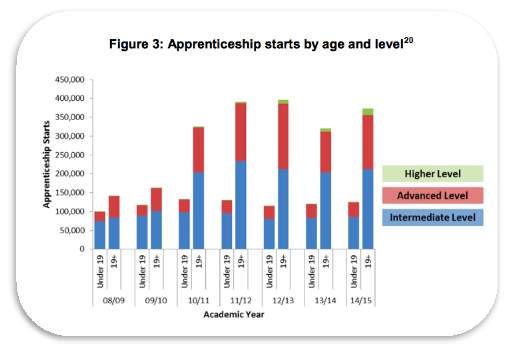
Figure six – Source: Javid and Morgan (2015).
Figure six illustrates the amount of apprenticeships which have started by age group, and the level for each academic year ranging from 2008 to 2015. The graph shows that there has been a steady amount of under 19 year olds starting apprenticeships, at both the intermediate and advanced level. However, this is not specifically for the construction industry as it indicates the amount of apprenticeships offered by the UK government however, the graph can only be used as an indicator. Therefore, we do not know the percentage regarding the construction industry to see if the UK government are trying to regenerate the industry.Nevertheless, there were 2.4 million apprenticeship starts in England over the last parliament, which is already more than double that of the previous period (1.1 million). We believe we can and should go further still according to Javid and Morgan (2015). Even though this is not directly linked to the construction industry, it does show the UK government have identified the shortage of apprenticeships across all sectors within the UK. Therefore, this links towards stating the UK government are providing support but no source has been found to state the percentage being relative towards construction. Nonetheless, with a population of ………. in the UK (percentage) does not seem sufficient to the author of this report.
Figure seven displays the amount of apprenticeships per thousand between 2008-2009. When looking at the amount of apprenticeships employed in England compared to other countries it shows that the UK government are not providing significant support to help companies provide apprenticeships.

Figure seven – Source: Javid and Morgan (2015).
2.8 Significances of Offering Education and Training Schemes
The UK government have established the need for training and education for the UK construction industry. As a result, the government have established the ‘Construction 2025’ scheme to help restore the industry and workforce, to capitalise on its potential opportunities (Mulcahy 2013).
The UK Government have identified that the industry continues to face significant skills shortages, with almost one fifth of all vacancies classified as hard to fill according to Mulcahy (2013). Furthermore, this has been supported as according to the UK government one fifth of all construction sector vacancies are persistent and hard to fill, due to the lack of qualification’s, skills and experience. Therefore, further investigation found that these shortages are predominantly in skilled trades and professional occupations. 53% of employers reported that in the construction contracting sector skill shortages in professional occupations however, 28% report skill shortages in trade occupations (GOV UK 2013). Therefore, the need for education and training is vital to help regenerate the construction industry. The main causes for this is the current “Tough economic conditions, which have led to a substantial fall in apprenticeship completions in construction related industries; from about 22,000 in 2008/09 to about 16,000 in 2011/12” (Mulcahy PAGE NO. 2013). Without attracting young talent into the industry through apprenticeships the industry will not be able to resolve the shortage of skilled labour and construction professionals.
Construction Industry Council’s (CIC) Jack Pringle believes training and education is crucial as the skill shortage is having a negative effect on the industry. Furthermore, believing that the need for architects, quantity surveyors (QS) and engineers are critical and therefore, the industry should be recruiting outside the UK and Europe (Hurst 2014). This statement is supported throughout chapter 2.0 regarding an increase in investment in personnel is needed to help regenerate the industry supported by figure eight.
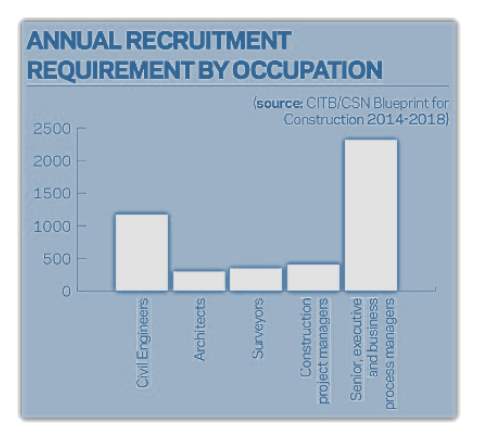
Figure eight – Source: Hurst 2014.
According to the blueprint for Construction 2014-2018, released by the CITB’s Construction Skills Network they have outlined the annual recruitment requirement in all professions shown in figure eight. However, it does not state the amount of skilled trades needed (Hurst 2014). Which has been identified as the most affected profession in the UK construction industry.
The UK government have issued a table showing the amount of apprenticeships being offered by the major sectors within the UK. Furthermore, showing the construction industry having the smallest amount of completions in the last three years.
UK Apprenticeships completions by major sector subject area.
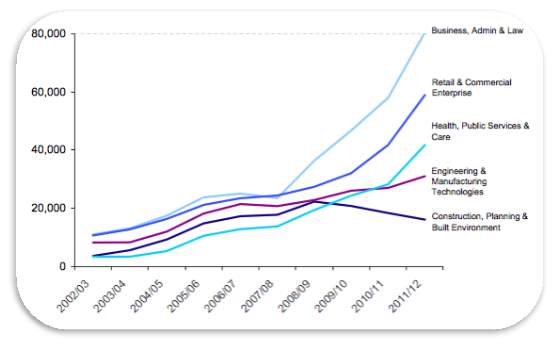
Figure nine – Source: GOV, UK. 2013.
Further investigation has indicated that the overall number of apprenticeships has increased between 2010-2015 nonetheless, among 16 to 19 year olds the number has decreased by 10,000. Therefore, this shows that the UK government are not doing enough to help the younger generation. However, this isn’t directly linked towards nevertheless, it does indicate that the UK government are not providing sufficient support across the UK as a whole (NEWS 2015). Linking back to figure eight which shows out of the major UK industries the construction industry provides the least amount of apprenticeships.
2.9 Literature Summary
Chapter two of the dissertation has critically reviewed literature relating to the research investigation; An investigation into the shortage of skilled labour and construction professionals due to economic changes impacting the UK construction industry since the 2008 recession. The focus is based upon the amount of apprenticeships offered by UK construction companies and UK government, whilst analysing whether the UK economy has contributed towards the shortage since the 2008-2009 recession. Therefore, exploring the UK governments policies for helping regenerate the UK construction industry by supporting the younger generation, before the aging workforce impact increases due to “nearly one in five construction workers are set to retire in the next 5-10 years” (Bannister 2016).
3.0 Research Methodology
3.1 Introduction
The following chapter justifies the research methods that have been used to gather the information to meet the investigation aim and objectives. Furthermore, it will discuss the benefits of each specific research method used throughout the report.
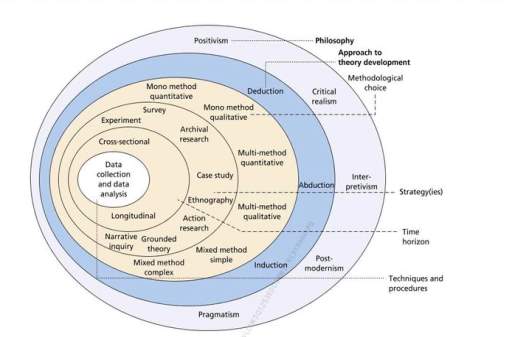
Figure ten – Source: Saunders et al., 2015.
Saunders et al., (2015) developed the research onion to illustrate the steps in which the researcher must follow when producing an applicable methodology to the research topic.
3.1.1 Research Aim
The research aimed to investigate the shortage of skilled labour due to economic changes impacting the UK construction industry since the 2008 recession.
3.2 Methodology Design
When deciding which research method to use an understanding of the meaning of research must first be obtained. The Oxford dictionary defines research as “The systematic investigation into, and study of, materials and sources in order to establish facts and reach new conclusions” (Thompson 2000, p863).
When considering research designs there are three main methods used: qualitative, quantitative and mixed methods. Cresswell (2009) stated that qualitative and quantitative research is typically generalised as the complete opposites. However, each are used for different ranges of research.
Furthermore, the distinctions between research methods can be categorised by the use of words (qualitative) or numbers (quantitative). or using closed-ended questions (quantitative hypothesis) opposed to open-ended questions (qualitative interview questions) (Creswell 2009).
3.3 Classifying Research
3.3.1 Purpose of Research
3.3.1.1 Exploratory
Exploratory research is adopted when there is a limited amount of previous knowledge surrounding a topic (Naoum 2013). The reasoning for using exploratory research is to explore the skill shortage within the UK construction industry by using semi-structured interviews to gain a clear and precise understanding from industry professionals.
3.3.1.2 Attitudinal Research
“Attitudinal research is used to ‘subjectively’ evaluate the ‘opinion’, ‘view’ or the ‘perception’ of a person, towards a particular object” (Naoum 2013, p43).
The purposed research method is used to obtain attitudinal research are questionnaires to establish the views of construction professionals about the UK construction industry.
3.3.2 Process of Research
3.3.2.1 Qualitative Research
“Qualitative research is ‘subjective’ in nature. It emphasises meanings, experiences, description and so on” (Naoum 2013, p41).
Exploratory and attitudinal research can be categorised under qualitative research (Naoum 2013). However, exploratory research is most fitting for qualitative research as it enables the researcher to gain a greater understanding on the research topic (Williams 2007). McMillian and Weyers (2011) stated different forms of techniques that can be used to gain qualitative research data collection these are: case studies and interviews.
Qualitative research approaches can only be used to analyse data in a small scale. Nonetheless, the data collected will be in-depth and provide a detailed insight into the area of study. However, the data collection can be used for ground-work for future investigation around the study topic. This investigation will consist of one form of qualitative research method which will be used in the form of interviews.
3.3.2.2 Quantitative Research
“Quantitative research is ‘objective’ in nature” (Naoum 2013, p39). It is typically ‘conclusive’ information used to base data collection on large unbiased samples (McMillian, K and Weyers J. 2011). Quantitative research is used when a researcher desires to collect factual evidence within the area of study to analyse against secondary research (Naoum 2013).
Quantitative research can be collected in the form of questionnaires, surveys, measurement and experiments. This investigation will consist of one form of quantitative research method, which will be used in the form of questionnaires.
3.3.2.3 Qualitative vs. Quantitative
Table two shown in Naoum (2013) summaries the differences between qualitative and quantitative research.
Table two – Source: (Bryman, 1998) taken from (Naoum 2013, p44).
| Quantitative | Qualitative | |
| 1 Role | Fact-finding based on evidence or records | Attitude measurement based on opinions, views and perceptions measurement. |
| 2 Relationships between researcher and subject | Distant | Close |
| 3 Scope of findings | Nomothetic | Idiographic |
| 4 Relationship between theory/ concepts and research | Testing/ confirmation | Emergent / development |
| 5 Nature of data | Hard and reliable | Rich and deep |
3.3.2.4 Secondary Research
Data collected through the desk study approach is called secondary data, due to data being obtained through other sources. Collecting secondary data has some significant advantages over primary data such as timesaving and cost reduction. (Naoum 2013).
Secondary research was used for the literature review (2.0). The secondary data was collected from numerous sources: online webpages, books, reports and journals, such as the CIOB and UK government. The secondary data collected was used to analyse against primary research to fulfil the requirements of the investigation.
3.3.3 Outcome of Research
3.3.4 Research Sampling Methods
To fulfil the requirements of this investigation the following qualitative and quantitative research method will be used: online questionnaire, via SurveyMonkey and email), and semi-structured interviews, through Face-to-face and telephone communications.
3.3.4.1 Structured Questionnaire
(See appendix A for questionnaire layout and structure)
Structured questionnaires have fixed questions and are prepared in advance of asking the participant. This allows the researcher to base the questions around a subject topic in order to meet the research aim and objective however, can limit the answers provided. The questionnaire method is the most widely used data collection technique for conducting surveys (Naoum 2013). It is required to obtain data through a mass audience quickly, which is analysed in section 4.0 to get the views of construction professionals.
The questionnaires were designed in two formats containing the same questionnaires to suit the participants needs. Zikmund (2013) suggested questionnaires must be designed to be as short as possible to ensure maximum amount of respondents. The questionnaire was focused around ten questions, which aimed to meet the aim and objectives of the investigation.
Questionnaires can be produced in several different formats these are; online, postal, email. Naoum (2013) stated that postal is perhaps the most widely used form of data collection when conducting surveys. Nonetheless, online and email questionnaires have been used for the collection primary data. These two techniques have been obtained to suit the participants needs and to reduce the need for printing. SurveyMonkey was the form of online survey published which has been advised on social media as well as contacting organisations directly.
3.3.4.2 Semi-structured Interview
(See appendix B for semi-structured interview structure)
A semi-structured interview is best suited in order to gain an in-depth insight into the research topic, by analysing construction professionals currently working within the industry. This data collection technique was used to analysed against the desk study from section 2.0.
There are three main formats of interviews: unstructured, semi-structured and structured. Unstructured interviews use ‘open’ or ‘open-ended’ questions, which allows the interviewee to have more control over their answers, whilst the researcher can analyse the direction the interviewee wants to go with. Semi-structured interviews are more formal and structured as the researcher has specific topics around which they build the interview with both ‘open’ and ‘closed-ended’ questions. Whereas, within a structured interview the interviewer dictates the questions across to the interviewee in the same order and with the same wording (Naoum 2013).
Merton and Kendal (1946) stated four distinguished characteristics of the semi-structured interview research method which are;
- Takes place with respondents known to have specific experience.
- It refers to situations that have already been analysed prior to the interview.
- It proceeds based on an interview guide specifying topics related to the research area.
- It focuses around the respondent’s experiences regarding to the study area (Naoum 2013).
The semi-structured interview was either telephone interviews or face-to-face subject to the interviewees’ requirements. The advantages are relevant to both data collection techniques.
3.4 Sampling
Selecting sampling methods requires great care in order to ensure characteristics of the sample population represent the whole population (Naoum 2013). The oxford dictionary defines a sample as “A small part or quantity to show what the whole is like” (Thompson 2000, p900). There are two main types of sampling outlined by Naoum (2013): random and selected sampling.
3.4.1 Random sampling
Random sampling is a procedure used within quantitative research for selecting participants (Cresswell 2014). It occurs when the characteristics of the sample are not critical. There are two criterions to consider when selecting the sampling method; what you want to know and whom you want to know it from (Naoum 2013).
3.4.2 Selected sampling
Naoum (2013) states when collecting qualitative data, using the selected sampling method is most appropriate (Naoum 2013). The selected sampling method is used when selecting participants on specific characteristics depend on the research data required.
For the current investigation, when collecting primary research and using the selected sampling method, a variety of construction professionals were selected dependent on their expertise and background within the industry. Each individual whom completed a semi-structured interview was chosen depending on their specific characteristics. Several different construction companies have been asked to complete and return the questionnaires. These companies are directly involved with recruiting construction professionals and skilled labour therefore, these companies have the requirements to provide professional data to be analysed.
3.5 Method of analysis
3.5.1 Triangulation
Bryman (1998) stated a ‘best of both worlds’ method by recommending that qualitative and quantitative approaches be combined. Therefore, both methods have been used to form triangulation using semi-structured interviews and questionnaires. When selecting the triangulation approach, the researcher collects both quantitative and qualitative data alongside each other this enables the researcher to compare the two forms of primary research to determine whether there are any similarities, differences or some combination (Creswell 2014).
3.6 Methodology Summary
Section 3.0 (Methodology) identified the different methods of research needed for the collection of data for the completion of the investigation. Section 4.0 will outline the methods for collecting primary data on the area of study.
4.0 Data Collection
4.1 Collecting Data
Section 4.0 clarifies the different methods in which qualitative and quantitative has been collected using primary data to investigate the aims and objectives for the dissertation.
4.2 Questionnaire Structure and Layout
The questionnaire contained ten questions to meet the aim and objectives in section 1.3 and 1.4 as well as the overall research question. The format of the questionnaire can be seen below in appendix A.
The questionnaire was constructed of predominantly closed-ended questions, which allowed the participants to self-complete the questionnaire over a short period of time. A number of ‘open-ended’ questions have been used throughout the questionnaire if the participant has any extra information they deem relevant to the research topic to expand on the ‘closed’ ended questions. Therefore, triangulation will be used to allow statistical data to be compared with qualitative and secondary research.
4.2.1 General overview
The first section of the questionnaire was designed to gain the participants opinion of the current situation within the construction industry regarding the shortage of skilled labour and construction professionals. ‘Closed-ended’ questions were adopted with the option to expand on their opinions. This format was adopted through the use of pilot questionnaires which did not have the option for the respondents to expand their views.
4.2.2 Lack of Apprenticeships
The second interview section focused on apprenticeship schemes and designed to uncover if respondents believed that the lack of apprenticeships contributed towards the shortage. The ‘closed-ended’ question format was used with a section to expand allowing the respondent to express their opinions regarding apprenticeships, and whether they believe it has contributed towards the skill shortage.
4.2.3 Organisations contribution towards shortage
Section three focused on the respondent’s organisation and whether their organisation is contributing to reducing the current skill shortage. This section focuses around three main schemes which organisations can contribute these are: apprenticeships, graduate schemes and training. ‘Open-ended’ questions were added for a further in-depth answer, allowing the researcher to get more information on the topic area. Therefore, ‘open-ended’ questions were added to the multiple-choice selections to allow the respondent to add any relevant information regarding how their organisation reduces the skill shortage.
4.2.4 UK Government
Section four addressed the UK government and their contribution towards the skill shortage. Questions aimed to uncover whether the respondents believed the UK government currently supports the younger population want to pursue a career within the construction industry. Therefore, investigating whether the government provide enough support with apprenticeships for the younger generation. Whilst also considering how the UK government are trying to help change the image perceived by others. A likert scale was used to gain a view of the respondent’s attitude towards the research topic.
4.2.4 2008-2009 Recession
Section five considers the UK recession during 2008-2009 ‘closed’ ended question allowed for a simple ‘yes’ ’no’ or ‘don’t know’ answer. Adopting this format allows specific answers to be analysed dependent on whether participants believe the UK recession directly affected the UK construction workforce and caused, or partially caused, the skill shortage.
(Explain 2008-2009 recession section)
4.2.5 Aging population
Section six mentions the aging population and whether this could cause another upsurge in regards to the skill shortage. A ‘closed’ ended question was used to turn the data into a percentage of people who believe the aging population is affecting the UK construction industry. A written ‘open ended’ question was added to allow the respondent to expand in-depth with reasoning as to why they believe the aging population is affecting the industry or not.
4.2.6 EU Migration
Section seven considers EU migration and the UK government to uncover if UK construction professionals believe that EU migration has caused a reduction in apprenticeships schemes offered, due to the increase of EU workers. A ‘Closed’ ended question was adopted to see the percentage of respondents who believed EU migration had an influence towards causing the skill shortage.
4.2.7 Covering letter
(Example of the covering letter will be shown in appendix A).
A cover letter was constructed, as it is the first and only opportunity to engage with the potential respondent. It was used to explain the reasoning behind the primary research and the purpose of the questionnaire. Questionnaires were sent out before interviews were undertaken, allowing the researcher to offer interviews to any potentially interested questionnaire respondents.
“A cover letter must succeed in overcoming any resistance or prejudice the respondent may have against the survey. It should (1) identify the sponsoring organisation or the person conducting the survey, (2) explain the purpose of the study, (3) tell why it is important that the respondent answer the questionnaire, and (4) assure the respondent that the information provided will be held strict confidence” (Naoum, S. 2013, p82)
The above statement from Naoum, (2013) identifies the key requirements that need to be considered when using a cover letter for a questionnaire, as it is essential for justifying why respondents are required to complete the investigation.
4.2.8 Questionnaire delivery and response
The number of questionnaires sent out was not limited in order to maximise potential respondents. The questionnaire was complemented with the cover letter and sent out in two different methods. The first method of data collection with questionnaires was through Surveymonkey, an online survey website. This was disturbed out through LinkedIn to construction professionals, and emailed to HR to a nominated contractor who sent it out to construction professionals within the organisation. The second method was a word published questionnaire, disturbed out to the same nominated organisation and to a variety of companies working within the construction industry.
The questionnaires were published and sent out on the 18th January 2017 and returned by 17th March 2017 to analyse the primary data.
4.2.9 Summary
The results gathered from the questionnaire are predominantly ‘closed’ ended questions and the quantitative research method identified in chapter 3.0 was used. The data collection from the questionnaires can be numerically processed for additional analysis.
4.3 Semi-structured interview
The second form of primary data collection method is the semi-structured interviews. This method was adopted to collect qualitative data to be compared with the quantitative data obtained from the questionnaires.
The structure of the interview consisted of ‘open’ ended questions to allow for a more in-depth explanation, compared to the predominantly ‘closed’ ended questions in the questionnaire.
4.3.1 Introduction
A concise introduction around the topic of research was given to the interviewee at the start of the interview outlining why the interview was being conducted. The first stage involved gaining consent and addressing confidentiality issues. Interviewees were asked if they were comfortable with interviews being recorded, followed by addressing the issue of confidentially in regard to the interviewee wanting to remain anonymous or be named within the research paper.
4.3.2 Background
The second stage of the interview investigated the interviewee within the construction industry and their position within the organisation currently employed by. Further investigation uncovered their background within the construction industry.
4.3.3 Overview of study and findings
The third stage included an overview of the topic area and allowed the interviewer to ask questions regarding the secondary research discovered within the literature review. It allowed for the interviewee to give in-depth responses to be given around the literature which can be seen in appendix B. Whereas, the second stage gained a more personal insight to the interviewees view of the skill shortage and which topic areas they believed had the biggest effect on the industry. Therefore, it allowed the researcher to get a construction industry workers views on the findings from literature to see if they agree with the literature found around the skill gap.
4.3.4 2008-2009 recession
The fourth stage covered the 2008-2009 recession, allowing the interviewer to get an insight into the interviewees organisation and how they believe the 2008-2009 affected their organisation. This also allowed for consideration as to how the interviewee believe it directly affected their organisations workforce.
4.3.5 UK government
The fifth stage considered the UK government therefore, investigated if the interviewee believed the UK government are currently providing enough incentives to help reduce the skill shortage, whilst considering any relevant legislations that could been used to solve the shortage for the future.
4.3.6 First-hand experience regarding skill shortage
The sixth stage investigated the interviewees’ first-hand experience within the industry regarding the shortage of skilled labour and construction professionals. This will allowed the interviewer to get a perception of how the industry professionals see the industry they are working in, and whether they believe something needs to do be done regarding the shortage or not.
4.3.7 Reducing the skill shortage
The seventh stage considers why the interviewee believes there has been a shortage of skilled labour. The interviewer will identify why they believe the shortage has occurred, for example aging workforce. The interviewer will then allow the interviewee to expand and suggest any other reasons why they believe the shortage has occurred.
4.3.8 Future of the industry
The eighth and final stage enabled the interviewer to gain an understanding of where the construction professionals believe the future of the construction is heading, for example advanced technology. Furthermore, interviewing several different construction professionals will allow the research to analyse different professional’s knowledge on the future of the industry.
5.0 Analysis of results
The following chapter will analyse the data collected from the primary research both the questionnaire (Appendix A and CD-ROM) and semi structured interviews (Appendix B). The recorded data will be analysed throughout section 5.0 along with the findings.
5.1 Questionnaire Analysis
Question: Do you believe that there is a shortage of skilled labour and construction professionals within the UK construction industry?

Analysis: Figure eleven illustrates 83% of respondents believed the UK construction industry was currently suffering from a shortage of skilled labour and construction professionals. This shows that the professionals currently working within the industry are aware of the shortage in labour and highlights a need for change to avoid increasing skill shortage. As found within the CIOB report, recording that 82% believed that there is a skills shortage within the construction industry (Townsend 2013). However, this source was from 2013 therefore, changes in data could occur. The 82% recorded by the CIOB increased by 5% on the 2012 figures. These findings show that the skill shortage is increasing furthermore, other literature has suggested that the industry is still currently being impacted by a skill gap. The findings show that the same amount of industry professionals believe that the shortage is similar than the figures recorded in 2013 nonetheless, the survey carried out for the completion of this investigation only consisted of 71 respondents whereas the CIOB report consisted of 1,346 respondents.
Question:If yes, why do you believe there is a shortage within the industry?
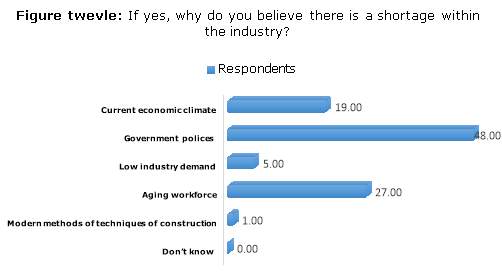
Analysis: 81% of respondents that believed there was a skill shortage stating they believed this was due to the UK government policies having a negative affect towards the skilled labour and professionals within the construction industry. This shows that although the industry professionals do believe the UK government have contributed towards the shortage, 46% specified the aging population as the shortage cause. Nevertheless, the main two causes identified interlink, as the aging population would not have arisen if the government introduced more apprenticeship schemes and other education methods. Supporting a study by Biggins (2016) who found 82% of UK workers suggested apprenticeships as a solution to the UK’s skill shortage. However, a full conclusion cannot be made as the figures are not identical but, an assumption can be made to indicate that government polices do need to be invested into to help support the construction industry. Nonetheless, further research on a larger sample is required across the UK as findings were based around the Midlands.
Question: Has the lack of apprenticeships contributed towards the shortage in skilled labour and construction professionals?
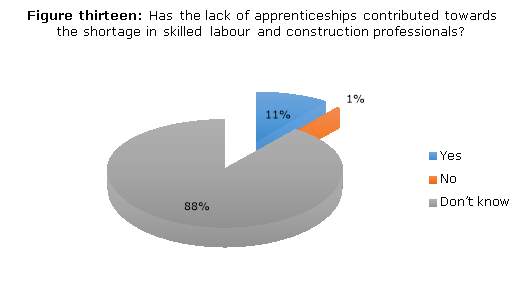
Analysis: 88% of the respondents believed the lack of apprenticeship schemes have contributed towards the current skills shortage. Furthermore, when interviewing industry experts, they also believed that the lack of apprenticeships contributed towards the shortage. When referring to the secondary data, a report carried out by the CIOB found 90% of CIOB members stated that apprenticeships are part of the answer to fixing skill gaps in the construction industry and supported by Biggins (2016) who found 90.6% respondents believed that apprentices make a valuable influence towards the workforce (Townsend 2013). However, this finding from Townsend is not directly linked towards the construction industry. Nonetheless, it does indicate the UK is being impacted from a skill gap. These secondary findings support the primary research as 88% believe the lack of apprenticeships has contributed towards the skill shortage.
Question: How does your organisation try to reduce the shortage of skilled labour and construction professionals?
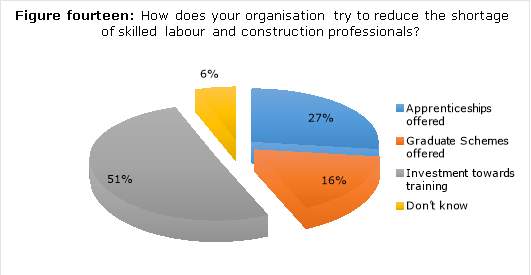
Analysis: When investigating the methods in which the respondent’s organisation tried to reduce the shortage of skilled labour and construction professionals. The primary data found investment towards training is how the majority of employers are attempting to solve the current skill shortage. This cannot be directly linked to the secondary research however, 57% of construction companies are currently providing training(Wiseman et al., 2014). Primary research has indicated that only 51% of respondents work for an organisation that are currently investing towards training for both existing or new employees. Further research in 2014 found that only 13% of employers had staff undertaking apprenticeships (Wiseman et al., 2014). Therefore, this can be linked towards the number of respondents whom organisation offers apprenticeships however, this cannot be support due to respondents working for the same organisation.
Question: In terms of construction professional apprenticeship schemes do you believe the UK government is providing a sufficient amount of support to help young people enter the industry?

Analysis: Figure fifteen illustrates 83% of respondents did not believe that the UK government are providing enough support to help the younger generation into the UK construction industry. When referring to the secondary research this data is support by the amount of apprenticeships start in 2015 dropped by (54.91%) compared to 2009 figures (Blackman, 2015). This shows that the support from the UK government in terms of apprenticeships offered has subsidiary dropped in recent years. Further research identified that figure eight (Chapter 2.0) suggests that the construction industry provides the least amount of apprenticeships in the UK compared to other major UK sectors, supporting the indication that the UK government are not providing enough support to help the younger generation. According to (NEWS 2015), the number of apprenticeship starts for 16 to 19 year olds has decreased by 10,000. Therefore, suggesting the UK government are not doing enough to help the younger generation and can be supported by the primary data.
Question: Do you believe the UK recession in 2008 has contributed towards the shortage in skilled labour?

Analysis: Figure sixteen illustrates 90% of the 71 respondents believed the 2008 recession contributed towards the current shortage of skilled labour in the UK construction industry. Comparable to secondary research by Martin (2016) stated that the construction industry employees 324,000 fewer workers in 2016 than it did in 2008. This shows that the 2008 recession continues to affect the UK construction industry and that it did have a negative effect on the skilled workforce due to the decline. (Expand?)
Question:When looking at the following techniques below, which do you believe is the most significant to help relieve future skilled labour shortages?
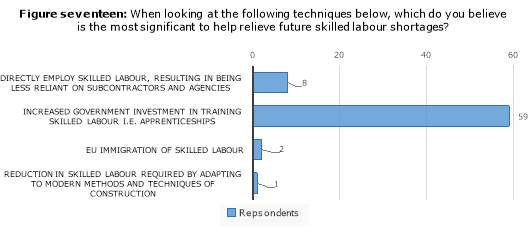
Analysis: Figure seventeen highlights 83.10% of respondents identified an increase in government investment in training and skilled labour would as most significant to helping the shortage of skilled labour. Therefore, suggesting the majority of industry professional believed apprenticeships are the best technique to resolve the current skills shortage.
In addition, secondary research a survey by the CIOB 2013 in figure five chapter 2.0 of this report, found 90.34% of respondents similarly believed that apprenticeships were the answer to fixing in the skill shortage. `However, the survey carried out by the CIOB was in 2013 SAY HERE WHY ITS BEING 2013 IS A DRAWBACK. Nonetheless, in 2015 there was a 4% drop on 2013’s figures for apprenticeship starts, indicating the UK government and UK construction companies continued to lack support for apprenticeship schemes despite previous research with industry professionals stating it as the best method for relieving a skills shortage.
Question: Do you believe the aging population within the UK construction industry could cause another upsurge regarding shortage of skilled labour?
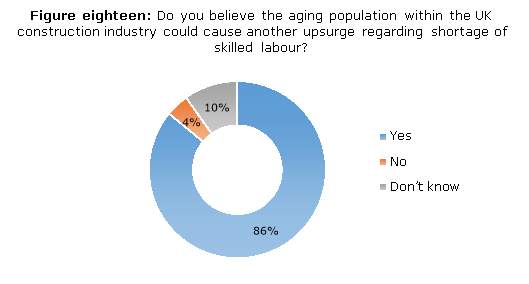
Analysis: Figure eighteen illustrates respondents stated the aging population as a cause for a further upsurge in the shortage of skilled labour. Similarly, figure four from the CIOB highlighted the age breakdown within UK construction industry and shows 64.8% of UK construction workers were 41+ years old. Furthermore, nearly one in five construction workers are estimated to retire in the next 5-10 years (Bannister 2016). As a result, this supports a 2013 CIOB survey which indicated 40.7% of CIOB members believed that the aging population is the biggest threat on the UK construction industry in 2013 (Barnes 2013). Therefore, if the younger generation do not enter the UK construction industry a further upsurge in shortage of skilled labour will occur.
Question: Do you believe EU migration has resulted in the reduction of UK government policies regarding apprenticeship schemes offered?

Analysis: Figure nineteen illustrates 45% believe that EU migration has resulted in the reduction of UK government policies. However, 28% of respondents did not know if it had affected the UK government’s policies therefore, this data cannot be conclusive and further research around this area needs to be constructed.
Nevertheless, secondary research stated that since the UK voted to leave the EU the availability of labour as free movement is anticipated to be restricted following the transition period (Wasniowski 2016). As a result, this will reduce the amount of EU workers currently reducing the impact of the skill shortage. Nonetheless, 45% of the authors respondents believe that the EU workforce are affecting the UK governments policies. Furthermore, the semi-structured interviews identified it is currently hard to recruit the right industry professionals stating EU workers do not all contain the right tickets as well as including the increasing language barriers currently occurring on construction sites. (Reword this section)
5.2 Interview Analysis
(See Appendix B for interview questions).
(See Appendix C and D for full interview transcripts).
Semi-structured interviews were conducted with industry professionals. The completion of the interview allowed for qualitative data to be collect through primary research to be used within this dissertation. The interviews allowed the interviewee to explain in-depth regarding their experience within the industry and their views on the industry and the current problems surrounding labour and construction professional shortage.
For confidentially reasons, the interviewees will remain anonymous and be replaced with ‘interviewee one’ and ‘interviewee two’.
5.2.1 Background
Both interviewees had vast experience within the construction industry both starting down the same route of engineer’s assistant, between the two interviewees they have over 50 years’ experience. Interview two is currently a project manager working on a variety of large construction projects within the UK construction industry, whilst interviewee one is a site manager / site engineer working predominately around London.
5.2.2 Overview of study and findings
Both interviewees agreed that there is a current skill shortage within the UK construction industry.
Interviewee one indicated that they found it hard to recruit a skilled workforce, whilst stating that they do believe the skill shortage is worsening year on year. Furthermore, stating that trade level workforce has been hit hardest suggesting they believe it is due to the lack of apprenticeship schemes currently offered by the UK government. Nevertheless, his organisation does invest heavily into training employees in recent years since the 2008 recession. However, the majority of their workforce at trade level is agency based so only investment into senior roles occurred predominately.
Interviewee two, a project manager, described the difficulty when recruiting the ‘right’ workforce due to a lack of skilled tradesmen currently available therefore, the current workforce is predominantly Eastern European due to always being able to recruit at trade level however, these employees do not have the required skills.
When referring to construction professionals at management level, interviewee two stated that they do not have a problem recruiting management due to the high levels of training in place. However, interviewee two stated his organisation is becoming top heavy due to the lack of tradesmen.
When investigating further the reasons interviewee two believed the industry is in a skill shortage, causes such as negative industry image and the lack of pay offered for apprenticeship schemes compared to other industries were highlighted.
When comparing the two interviews both stated they believed there was a skill shortage, whilst indicating they can still recruit a workforce however, candidates do not always process the desired skills. Equally, both interviewees believed apprenticeship schemes would ease the current skill shortage. However, interviewee two stated ,to do so, an increase in pay is required to attract the younger generation to compete with other industries.
5.2.3 2008-2009 recession
In regard to the 2008-2009 recession, both interviewees indicated the recession had affected their companies due to the lack of investment from both the UK government and their construction organisation, resulting in redundancies throughout the organisation. However, interviewee two believed this to be a positive, as it allowed the organisation dispose of underperforming staff. However, it still was a challenging period for the organisation due to the reduction in work having a negative effect on employing a younger workforce into the organisation, through graduate or apprenticeship schemes. Interviewee one suggested the main causes were the lack of investment from UK construction companies and government.
Interviewee two believed the 2008 recession continues to have a negative effect on the construction industry, due the main effects of the recession on the skill shortage are the low wages and lack of investment from UK construction companies and government. Support by the findings from the alternative questionnaire, which found 90% of respondents believed that the 2008-2009 recession influenced the skill shortage.
Nevertheless, interviewee one then suggested that EU migration aroused more noticeably after the 2008-2009 recession within the industry, resulting in a lack of investment from the UK government when referring to apprenticeship schemes. This section allowed the interviewer to identify the common statements from both interviewees with regards to the lack of investment provided to the industry.
5.2.4 UK government
When discussing the UK government, interviewee one suggested that the UK government must invest more money into the construction industry, supporting figure nine in Chapter 2.0 (GOV, UK. 2013). Similarly, supported by interviewee two who stated, “Both investment from the UK construction companies as well as the UK government is required” (Interview two to Walker, 2017). This identifies the UK major sectors by amount of apprenticeship completions showing the construction industry as the lowest. However, interviewee one did state they do not consider the UK governments policies regarding apprenticeship schemes offered.
Interviewee two discussed that low advertising for working within the construction has affected the industry negatively, further suggesting the UK government should help change the industry image to help recruit a larger workforce. When mentioning the CIOB’s target to recruit 3 million apprenticeships over the next five years, interviewee two believed the target is achievable. However, stated both the UK government and UK construction companies need to increase wages due to other industries offering enhanced salaries, then changed their initial agreement due to believing in reality it probably will not be achievable.
5.2.5 First-hand experience regarding skill shortage
When referring to both interviewees first-hand experience. Interviewee one stated that his organisation recruit’s trade workers through specific agencies and indicated his organisation does not want to directly employ trade workers. However, stated the quality of the workforce through agencies is not up to the required standard. Therefore, believed by investing into apprenticeship it will allow companies to retain a quality labour workforce.
Similarly, interviewee two’s organisation recruits 90% of their skilled labour workforce from a select group of agencies resulting in high turnover of staff throughout the organisation. Interviewee two stated that they had witnessed the skill shortage first hand, due to the challenges faced every day when trying to recruit a skilled workforce. Expanded further by explaining potential candidates lack the required training or tickets to complete the jobs efficiently.
When comparing the two interviews, it is evident that both interviewees have issues recruiting a quality workforce, and both identified that apprenticeships would ease the skilled labour shortage. This can be support by additional primary research, which indicated that 83.10% of respondents believed that an increase in government investment in training or apprenticeships would be most beneficial and solve the current shortage of skilled labour.
5.2.6 Reducing the skill shortage
Interviewee one, suggested that companies need to invest more in regard to apprenticeships however, this will require more investment from the UK government. Industry image was also indicated as a change that is required to help ease the skill shortage, as it would help recruit the younger generation into the industry. Furthermore, interviewee two believed trade apprenticeships would decrease the current skill shortage however, would require the industry image to improve alongside wages for the apprenticeship schemes to appeal to potential employees.
As noted, both interviewees had the same opinion regarding helping reduce the current skill shortage, support by the findings from the questionnaire and secondary research within the literature review. The questionnaire found 88% of respondents believed the lack of apprenticeships as the main cause for the current skill shortage, supported by a report by Biggins (2016) who found 90.6% of construction professionals believe that apprentices create valuable contribution towards the workforce therefore, reducing a skill shortage.
5.2.7 Future of the industry
When discussing the future of the construction industry, interviewee one believed the construction industry is always going to remain. However, noted the need for change within the industry to avoid the industry continuing to suffer and a decline in the quality of work. In order to help the change the importance of the UK construction companies and the UK government in terms of increasing the amount of investment was stressed.
Similarly, interviewee two believed that the skilled labour shortage would continue to increase due to the industry being undesirable to a younger generation when compared to other industrys with better working environments. However, as a solution, interviewee two stated that if apprenticeship schemes improve within the next 5-10 years it would slowly ease the shortage, again stressing the need for investment from UK construction companies and the UK government.
The literature review in chapter 2.0 can support the current findings, as the UK governments want to create 3 million apprenticeships over the next five years. Therefore, introducing levy to support apprenticeships by enforcing large companies to invest into the levy. (O’Connor, S. 2015). As the growing body of literature grows it highlights…. through This shows that as well as both interviewees the UK government and several other authors identified within chapter 2.0 indicate that apprenticeships are the future of the industry.
6.0 Conclusion
6.1 Introduction
This is the final chapter of the dissertation, it will include a summary conclusion for each objective, whilst making recommendations for future studies around the topic area and indicating limitations.
6.1.1 Objective one
“To provide an overview of the construction industry whilst referring to the construction industries skill shortage.”
Throughout the study the construction industry has been acknowledged regarding the skill shortage. Chapter 2.0 identified an overview of the current UK construction industry and the impact it has on the UK. Rhodes (2015) stated that the UK construction industry was a significant sector within the UK economy contributing £103 billion in output during 2014. Therefore, contributing 6.5% of the UK’s total economic output.
The findings above indicate that the UK construction industry is fundamental towards the UK economy.
6.1.2 Objective two
“To examine the UK governments apprenticeship schemes implemented for the UK construction industry.”
6.1.3 Objective three
“To analyse the impacts of the 2008 recession within the UK construction industry and its skilled labour workforce.”
The data collected from the questionnaires indicated that 90% of respondents notice the effects of the 2008-2009 recession directly on the construction industry. Furthermore, according to both interviewees their companies were both directly affected by the recession referring to a lack of work, redundancies to name a few.
6.1.4 Objective four
“To review the issues regarding the aging population within the construction industry and how its contributed towards the skill shortage.”
6.1.5 Objective five
“To establish the potential solutions for overcoming the current skill shortage within the construction industry.”
6.2 Recommendations
The recommendations proposed for investigating this topic area are:
- To attract the younger generation into the construction industry by changing the industry image.
- UK government to provide extra support to UK construction companies to help the younger generation get into the industry through apprenticeship schemes.
Furthermore, for additional investigation around this topic area extensive primary research is recommended to establish a more in depth conclusion towards the research title.
6.3 Limitations
The main limitations encountered during the completion of this investigation were the limited use of companies for the respondents towards the questionnaires. This was due to the lack of contacts within the industry. Subsequently, limiting the number of respondents nonetheless, limiting the data collection to regional areas such as the midlands. Therefore, incorporating cost and time restrictions for the questionnaires to be sent nationally. Furthermore, the primary research does not represent the UK as a whole. These limitations have limited the scope of the study and therefore, affected the reliability.
Furthermore, another issue with the investigation the limited respondents to the interview stage. Due to both interviewees working for similar organisations it has limited the answers provided for the completion for this research. Nonetheless, only two personal opinions limiting the data collected.
References
Allen, K., 2016. UK Construction Sector Suffers Sharp Slowdown [online]. Guardian. Available at: https://www.theguardian.com/business/2016/may/13/uk-construction-sector-suffers-sharp-slowdown-ons [Accessed 09/01 2017].
Bannister, D., 2016. Skill sector shortage grows in the construction sector [online]. In Sync Outsourcing. Available at: https://www.insync-uk.com/news-opinions/skill-sector-shortage-grows-in-the-construction-sector/ [Accessed 11/3 2016].
Barnes, D., 2013. Skills in the UK construction industry. 1st ed. Online: Chartered Institute Of Building.
Biggins, L., 2016. Apprenticeships are THE solution to the UK’s skills gap [online]. Recruitment Buzz. Available at: http://recruitmentbuzz.co.uk/apprenticeships-are-the-solution-to-the-uks-skills-gap/ [Accessed 28/03 2017].
Blackman, D., 2015. Apprentices in construction: one step forward [online]. building.co.uk. Available at: http://www.building.co.uk/apprentices-in-construction-one-step-forward%E2%80%A6/5074217.article [Accessed 03/15 2017].
Boles, N., 2014. Government kick-starts plans to reach 3 million apprenticeships [online]. CITB. Available at: https://www.gov.uk/government/news/government-kick-starts-plans-to-reach-3-million-apprenticeships [Accessed 10/30 2016].
Breuer, Z., 2012. Sector Skill Assessment: Construction, Building Services Engineering and Planning. Webpage: UK Commission for Employment and Skills.
Bridges, L., 2016. Government Construction Strategy 2016-20. Webpage: Infrastructure and Projects Authority.
CIOB, 2009. Skills in the construction industry. Webpage: CIOB.
CIOB, A., 2013. Skills Report 2013 [online]. CIOB. Available at: http://www.ciob.org/content/skills-report-2013 [Accessed 30/10 2016].
CIOB, A., 2009. The impact of the ageing population on the construction industry. Webpage: CIOB.
CITB, 2017. Apprenticeship levy and construction [online]. CITB. Available at: http://www.citb.co.uk/levy/apprenticeship-levy-construction/ [Accessed 23/03 2017].
CITB, 2016. 100m construction skills centre planned for London [online]. CITB. Available at: http://www.citb.co.uk/news-events/england/london/100m-construction-skills-centre-planned-for-london/ [Accessed 11/02 2016].
Cockroft, S., 2015. Britain hit by worst skills shortage for 30 years – but it means you can earn 100,000 a year as a plumber aged just 19 if you’re prepared to graft. Mail Online (News), 11/02, Online Article.
Cohen, D. and Crabtree, B., 2006. Semi-structured interviews [online]. Robert Wood Johnson Foundation. Available at: http://www.qualres.org/HomeSemi-3629.html [Accessed 11/04 2016].
Cresswell, J., 2009. Research Desgin. fourth ed. Book: Sage Publications.
Finance, W., 2016. Questionnaire [online]. Business Dictionary. Available at: http://www.businessdictionary.com/definition/questionnaire.html [Accessed 11/03 2016].
Frogner, M., 2002. Skill Shortages. Webpage: Office for National Statistics.
GOV, 2014. Funding for apprenticeships helps small business and post graduates [online]. GOV. Available at: https://www.gov.uk/government/news/funding-for-apprenticeships-helps-small-business-and-post-graduates [Accessed 01/25 2017].
GOV, U., 2013. UK Construction: An economic analysis of the sector [online]. UK Government. Available at: https://www.gov.uk/government/uploads/system/uploads/attachment_data/file/210060/bis-13-958-uk-construction-an-economic-analysis-of-sector.pdf [Accessed 27/03 2017].
Hurst, W., 2014. Skills shortage let the right ones in [online]. Building.co.uk. Available at: http://www.building.co.uk/skills-shortages-let-the-right-ones-in/5066615.article [Accessed 27/03 2017].
Javid, S., and Morgan, N., 2015. English Apprenticeships: Our 2020 Vison. Edition 1 ed. Webpage: HM Government.
Kollewe, J., 2016. Brexit would lead to shortage of construction staff, says Barratt boss [online]. The Guardian. Available at: https://www.theguardian.com/business/2016/may/11/brexit-shortage-construction-staff-barratt-housebuilding-uk-eu-referendum [Accessed 28/03 2017].
Linford, N., 2016. Funding rates cut by up to 50% for most deprived 16-18 apprenticeships [online]. FE WEEK. Available at: http://feweek.co.uk/2016/08/19/exclusive-funding-rates-cuts-up-to-50-for-the-most-deprived-16-18-apprentices/ [Accessed 23/03 2017].
Martin, N., 2016. Millennials are the key to construction’s skills shortage, we need to engage them [online]. The Guardian. Available at: https://www.theguardian.com/lendlease-redesigning-cities-zone/2016/jul/26/millennials-are-the-key-to-constructions-skills-shortage-we-need-to-engage-them [Accessed 10/30 2016].
McMillan, K., and Weyers, J., 2011. How to write dissertations and project reports. 2nd ed. Dawsonera: Prentice Hall – M.U.A.
Mulcahy, T., 2013. Construction 2025. Webpage: HM Government.
Naoum, S., 2013. Dissertation Research & Writing for Construction Students. Third ed. Book: Routledge.
NEWS, B., 2015. Too few young people becoming apprentices, says MPs [online]. BBC News. Available at: http://www.bbc.co.uk/news/education-31755666 [Accessed 28.03 2017].
O’Connor, S., 2015. UK employers call for quality apprenticeships [online]. Financial Times. Available at: https://www.ft.com/content/4293ce4e-4c20-11e5-b558-8a9722977189 [Accessed 28/03 2017].
Pettinger, T., 2012. UK Construction Sector Growth Stats [online]. Economics Help. Available at: https://www.economicshelp.org/blog/wp-content/uploads/2012/11/constuction-percent-change.png [Accessed 10/30 2016].
Prior, G., 2016. Hard brexit will cost construction 215,000 workers [online]. Construction Enquirer. Available at: http://www.constructionenquirer.com/2016/11/30/hard-brexit-will-cost-construction-215000-workers/ [Accessed 01/10 2017].
Quinn, L., 2013. The 5% Club of apprentices can build a better British economy. The Telegraph (Finance), November, 1-Online.
Rhodes, C., 2015. Construction Industry: statistics and policy. 01432nd ed. Online: House of Commons library.
Rhodes, C., and Wilson, W., 2016. Brexit: implications for the housing market and construction industry. 07666th ed. Webpage: House of Commons Library.
Richardson, S., 2007. What is a skill shortage? Web edition ed. Webpage: National Vocational Education and Training Research and Evaluation (NVETRE).
Rodionova, Z., 2016. Freedom of movement ‘vital’ to UK construction post Brexit, industry experts warn Government [online]. Independent. Available at: http://www.independent.co.uk/news/business/news/brexit-latest-freedom-of-movement-uk-construction-warning-a7307246.html [Accessed 10/30 2016].
Rohner, F., 2016. The Impact of the Great Recession on the Construction Industry [online]. iHire LLC. Available at: https://www.ihireconstruction.com/careeradvice/pages/the-impact-of-the-great-recession-on-the-construction-industry [Accessed 09/01 2017].
Ruiz, Y., 2004. Skills shortages in skilled construction and metal trade occupations. Webpage: National Statistics feature.
Sadek, J., 2015. Skill gap nothing new [online]. . Available at: http://www.estatesgazette.com/blogs/jackie-sadek/2015/06/skills-gap-nothing-new/ [Accessed 01/04 2017].
Shah, C., and Burke, G., 2003. Skill Shortage: concepts, measurement and implications. 52nd ed. Webpage: Monash University – Acer Centre for the Economics of Education and Training.
Sheffield, H., 2016. UK construction shrinks at fastest pace since 2009 after Brexit vote. The Independent – Business News, 02/08/2016, 1.
Stocks, T., 2016. Skills Shortage in Construction [online]. Faithful Gould. Available at: https://www.fgould.com/uk-europe/articles/skills-shortage-construction/ [Accessed 01/04 2017].
Thompson, D., 2000. The Oxford compact English dictionary. 2nd ed. New York: Oxford University Press.
Townsend, S., 2013. CIOB: Skills shortages still a concern for faltering construction industry [online]. CIOB. Available at: http://www.politics.co.uk/opinion-formers/ciob-chartered-institute-of-building/article/ciob-skills-shortages-still-a-concern-for-faltering-construc [Accessed 10/30 2016].
Trueman, C., 2006. Structured Interviews [online]. The History Learning Site. Available at: http://www.historylearningsite.co.uk/sociology/research-methods-in-sociology/structured-interviews/ [Accessed 11/04 2016].
Walker, S., 2015. Recruitment looks within as skill shortage bites [online]. Construction News. Available at: https://www.constructionnews.co.uk/data/employment/recruitment-looks-within-as-skills-shortage-bites/8684466.article?blocktitle=Employment-analysis&contentID=10105 [Accessed 11/01 2016].
Wilkinson, P., 2016. What ‘a hard brexit’ means for skills [online]. Skills Planner. Available at: http://www.skillsplanner.net/tag/skills-gap/ [Accessed 01/10 2017].
Wilkinson, P., 2014. The poor mage of UK construction [online]. PWCOM. Available at: http://blog.pwcom.co.uk/2014/12/22/the-poor-image-of-uk-construction/ [Accessed 23/03 2017].
Williams, C., 2007. Research Methods. Journal of Business & Economic Research – Research Methods, 5 (3), 65-66-72.
Wiseman, J., Roe, P. and Parry, E., 2014. Skills and training in the construction industry 2014 [online]. BMG Research. Available at: https://www.citb.co.uk/global/banners/192px/citb%20skills%20and%20training%20in%20the%20construction%20industry_final%20report%202014.pdf [Accessed 10/30 2016].
Zikmund, W., Babin, B., Carr, J. and Griffin, M., 2013. Business Research Methods. Ninth ed. Online: South-Western Cengage Learning.
Bibliography
Dainty, A., Green, S., Bagilhole, B., 2007. People and culture in Construction: A reader [eBook]. 1st Ed. Abingdon: Taylor & Francis. Available via: LibraryOneSearch [Accessed 27 March 2017]
GOV, 2017. Apprenticeship grant for employers of 16 to 24 year olds [online]. GOV. Available at: https://www.gov.uk/government/collections/apprenticeship-grant-for-employers-of-16-to-24-year-olds [Accessed 01/25 2017].
Appendix
Appendix A
(Example questionnaire and cover letter layout)
Nottingham Trent University – Construction Management BSc (Hons)
The questionnaire is used is for the fulfilment of Construction Management BSc (Hons) for completion of a dissertation regarding the below statement:
‘An investigation into the shortage of skilled labour and construction professionals due to economic changes impacting the UK construction industry since the 2008 recession’.
I would greatly appreciate your participation in filling out the below questionnaire to help me conduct primary research regarding the shortage of skilled labour and construction professionals. If I could please ask for the questionnaires to be completed by the 17th March 2017, to enable me to process all the research.
All information will be anonymous and will only be used for the purpose of this dissertation.
In the meantime, if you would like to take part in a semi-structured interview either over the phone or video call please don’t hesitate to get in contact with me.
Q1) Do you believe that there is a shortage of skilled labour and construction professionals within the UK construction industry?
Yes No Don’t Know
Q2 If yes, why do you believe there is a shortage within the industry?
| Reason | Please tick if appropriate |
| Current economic climate. | |
| Government polices i.e. lack of apprenticeships offered. | |
| Low industry demand. | |
| Aging workforce. | |
| Modern methods and techniques of construction. | |
| Don’t know. | |
| Other reasons? Please comment below. |
………………………………………………………………………………………………………………………………
Q3) Has the lack of apprenticeships contributed towards the shortage in skilled labour and construction professionals?
Yes No Don’t Know
If yes, please explain how below.
…………………………………………………………………………………………………………………………………………………………………………………………………………………….…………………………………………Q4) How does your organisation try to reduce the shortage of skilled labour and construction professionals?
| Reason | Please tick if appropriate |
| Apprenticeships offered. | |
| Graduate Schemes offered. | |
| Investment towards training | |
| Don’t know. | |
| Other reasons? Please comment below. |
……………………………………………………………………………………………………………………………..
……………………………………………………………………………………………………………………………..
Q5) In terms of construction professional apprenticeship schemes do you believe the UK government is providing a sufficient amount of support to help young people enter the industry?
Strongly Agree Agree Neutral Disagree Strongly Disagree
Q6) Do you believe the UK recession in 2008 has contributed towards the shortage in skilled labour?
Yes No Don’t Know
Q7) When looking at the following techniques below, which do you believe is the most significant to help relieve future skilled labour shortages?
Directly employ skilled labour, resulting in being less reliant on subcontractors and agencies.
Increased government investment in training skilled labour i.e. apprenticeships.
EU immigration of skilled labour.
Reduction in skilled labour required by adapting to modern methods and techniques of construction.
Q8) Do you believe the aging population within the UK construction industry could cause another upsurge regarding shortage of skilled labour?
Yes No Don’t Know
If yes, please explain below.
…………………………………………………………………………………………………………………………………………………………………………………………
Q9) Do you believe EU migration has resulted in the reduction of UK government policies regarding apprenticeship schemes offered?
Yes No Don’t Know
Additional Feedback.
Please share below any additional information relevant to the questionnaire topic.
………………………………………………………………………………………………………………………………………………………………………………………………………………………………………………………………………………………………………………………………………………………………………………………………………………………………………………………………………………………………………………………………………………………………………………………………………………………………………………………………………………………………………………………………………………………………………………………………………………………………………………………………………………………………………………………………………………………………………………………………………………………………………………………………………………………………………………………………………………………………………………………………………………………………………………………………………………………………………………………………………………………………………………………………………………………………………………………………………………………………………………………………………………………………………………………………………………………………………………………………………………………………………………………………………………………………………………………………………………………………………………………………………………………………………………………………………………………………………………………………………………………………………………………………………………………………
Thank you for taking the time to fill out this questionnaire, as I rely on your feedback to complete my dissertation for fulfil of Construction Management BSc (Hons).
Appendix B
(Questions asked within interview one and two)
| Section | Interview One | Interview Two |
| Section one – Background. |
|
|
| Section two – Skill Shortage |
|
|
| Section 3 – Investment |
|
|
| Section 4 – 2008 recession |
|
|
| Section 5 – Reducing the shortage |
|
|
| Section 6 – First-hand experience |
|
|
| Section 7 – Future of the industry |
|
|
| Section 8 – Further opinions |
|
Appendix C
(Interview one transcript)
Q1) Firstly, I would like to get an understanding about your background within the construction industry and where you started off.
- I’m a setting out engineer / site manager for a civil engineering company. I have worked within the industry 21 years I started as a chain boy as well as attending college to train to be a site engineer.
Q2) My topic is surrounding the shortage of skilled labour and construction professionals. The dissertation question itself is: ‘An investigation into the shortage of skilled labour and construction professionals due to economic changes impacting the UK construction industry since the 2008 recession’. When investigating this topic, the most recent report carried out by the CIOB in 2013 stated that 82% believe a skills shortage exists in the construction industry, a 5% increase from the 2011 survey. To what extent do you agree?
- I agree with the above statement, that the skill shortage is currently still getting worse.
Q3) When investigating the CIOB report further 46% thought that a lack of investment from the industry and government was the biggest threat to the future skills. Do you agree?
- I don’t have a great understanding around the lack of investment with regards to the government. However, I know that my organisation does invested in training employees within the group. However, I do believe that investment does contribute towards the skill shortage as only in recent years has my organisation started investing more into training employees with regards to construction professionals. However, the majority of our skilled labour is agency based so limited investment and training is provided.
Q4) Looking further into the government investment does your organisation offer apprenticeship schemes and graduate schemes?
- Only in recent years (2-3 years) have we started recruiting apprenticeship schemes, especially within our plant department. Graduate schemes have been offered throughout the company for a while now however, they didn’t employ many graduates around the 2008 recession.
Q5) Why do you believe there has been a shortage of skilled labour and construction professionals within the UK construction industry?
- The older generation are not being replaced at a quick enough rate, which has caused the upsurge in shortage of skilled labour on our construction sites. As an organisation, we have becoming to top heavy and cannot recruit enough skilled workers to cope with the demand. This is because people do not want to go out on a building site anymore due to the increase in technology and office based work. The UK government are not making the construction industry have a desirable image to recruit the younger generation.
Q6) With regards to the recession in 2008, how did it affect your organisation? I.e. lack of skilled workforce, lack of younger generation entering the construction industry through apprentices, less work due to low demand, cash flow difficulties, redundancies etc.
- When the 2008 recession hit the UK, the workload reduced massively resulting in some companies within the group making cuts to the workforce through redundancies. Furthermore, the working hours were reduced as well as Saturday work. Weekly and attendance bonuses were stopped.
Q7) Did the 2008 recession have a direct effect of skilled labour?
- Every industry was affected by the 2008 recession not just the construction industry however, the construction industry is still recovering from the recession with regards to skilled labour. The main reasons for the recession affecting the construction industry so badly is due to the lack of investment from construction companies and the government resulting in a reduction in training the workforce. I believe because of this we have seen an increase in EU workers in the construction industry.
Q8) The UK construction industry employs 324,000 fewer workers than it did in 2008? Do you believe this is because of the 2008 recession still having a negative effect on the industry?
- Yes, the 2008 recession did have a negative effect on the industry however, this is not the only reason we see a shortage of workers in the construction industry. New technology is being used requiring less operatives on site however, even with the decrease in workers needed due to technology advances we still cannot recruit enough skilled labour on our sites.
Q9) Do you believe construction companies and the UK government are doing enough to reduce the shortage in skilled labour when referring to apprenticeships?
- I do not consider the UK government policies regarding apprenticeships however, I would say that the UK government are not investing enough money into the industry which will concern the amount of apprenticeships offered.
Q10) In 2015, the number of apprenticeships completed was 9,306 which represents a 4% drop on 2013’s already low figure of 9,688, continues a decline from a high point in 2009 when 16,947 apprentices were completed. With this decline to believe the UK government are at vault for the decrease in apprenticeship figures.
- Yes, with the figures stated in the question it shows that the UK government are involved with the decrease in apprenticeships completed however, UK construction companies are also involved in the decrease in apprenticeships between 2009-2015.
Q11) Do you believe apprenticeships are the way forward for reducing the skilled labour shortage?
- Yes, I believe that apprenticeships are the way forward mainly regarding the trade apprenticeships as the trades are now dying. I believe this is more beneficial that graduate schemes. As I have witnessed first-hand throughout my organisation that there is a greater lack of skilled tradesman than there are of construction professionals. However, I have only worked for one construction firm throughout my career so I have only witnessed this for one construction company and I believe my organisation struggles to recruit skilled tradesman rather than construction professionals i.e. project managers.
Q12) Have you witnessed first-hand a shortage of skilled labour and construction professionals in the UK construction industry?
- My organisation recruit’s tradesman through agencies due to not having enough of our own. Therefore, we go to specific agencies to recruit or labour workforce. Generally, the quality of the workforce from agencies isn’t up to the required standard resulting in a high level of staff turnover until we find a suitable person who is up to the required standard. Investing into apprenticeship schemes will help companies to maintain a quality labour workforce.
Q13) Linking back to Q4, do you believe your company are not investing enough into their workforce.
- When looking from that perspective then maybe there isn’t enough investment from my company regarding tradesman. As, they may argue that they are doing enough as they do invest heavily into training their employees however, they mainly recruit office based / management rather than tradesman. The reasoning behind why they may not directly recruit tradesman is due to the uncertainty of winning work and being able to provide consistent work so it is easier to employ agency staff when and where required.
Q14) Do you believe that if your organisation directly employed their tradesman do you think this would help ease the shortage whilst also thinking about this on a wider scale?
- Yes, but do construction companies want to employ tradesman directly due to the uncertainty of work. As well as the uncertainty of work they will also have to including paying; sick pay, holiday pay etc. Which means the costs incorporated permanent.
Q15) What do you believe needs to be done to reduce the shortage of skilled labour and construction professionals within the UK construction industry?
- Companies need to invest more in ways of apprenticeships and other government schemes however, this will require more investment from the UK government as well. Alongside investment changing the industry image to help recruit the younger generation into the industry. This can be incorporated by promoting a better image from a young age for example during school years.
Q16) Where do you see the future of the construction industry going?
- The construction industry is always going to continue however, unless something is going to be done the industry will continue to suffer and quality of work throughout the industry will continue to decline. Technology will be introduced however; a quality workforce will still be required even with the introduction of new technology. Therefore, UK construction companies and the UK government do need to act and increase the amount of investment to help solve the shortage of skilled labour as a labour workforce will always be required.
Q17) Do you have any further information to add surrounding this topic or thoughts?
- Also, the lack of quality through companies not investing into recruiting their own employees. A high number of the workforce are now coming from eastern Europe, construction companies will believe this will help them due to cheaper wages however, I believe it’s only a short-term solution due to the quality of work not being good enough in my experience.
REORDER ANSWERS AND QUESTIONS.
Firstly, I would like to get an understanding about your background within the construction industry and where you started off.
- I started in 1986 as a chainman (engineer’s assistant) I didn’t know anything about the job I just wanted to get a job to earn as much money as I could so it wasn’t my chosen profession. I worked as a chainman for 4-5 years until I worked my way up to be a site engineer I started running my own jobs until I worked my way up to become a site manager before becoming a project manager.
Q2) My topic is surrounding the shortage of skilled labour and construction professionals. The dissertation question itself is: ‘An investigation into the shortage of skilled labour and construction professionals due to economic changes impacting the UK construction industry since the 2008 recession’. When investigating this topic, the most recent report carried out by the CIOB in 2013 stated that 82% believe a skills shortage exists in the construction industry, a 5% increase from the 2011 survey. To what extent do you agree?
- I totally agree, every year you find it more difficult to get people to do the job properly apart from Eastern Europeans nobody from England everyone wants to get office based computer jobs rather than more hands-on jobs. I think it’s since the introduction of computers everybody has gone that way rather than the ways in the olden days. The pay used to better before than what it is day compared to computer and office based jobs pay.
Q3) When investigating the CIOB report further 46% thought that a lack of investment from the industry and government was the biggest threat to the future skills. Do you agree?
- Partly, people from school are going to go for jobs which give them the most money in my opinion. Now, computer jobs are paying better salaries than the construction industry. People do not want to go out in the rain and get dirty anymore. The main reason for the shortage in my opinion is the wages. However, investment in training does have an effect however, you do need to get people into the construction industry first. Therefore, both wages and investment from the UK government are both linked towards the shortage. My organisation is currently setting up a training facility in one of our offices to train for the future however, these people are already working in the construction industry so the shortage has occurred through not being able to recruit people into the construction industry.
Q4) Would you say it’s the construction industries image that prevents people from not wanting to work within the industry?
- Yes, that’s correct because there’s nicer environments for people to work in nowadays with the same salaries or better so people do not want to work outside getting hands on.
Q5) Why do you believe there has been a shortage of skilled labour and construction professionals within the UK construction industry?
- As I’ve said everybody wants a nice easy job for English people, so Eastern Europeans come over to the UK to earn the better salaries and do not mind learning a trade to work within the construction industry on a better salary than they would in their national country.
Q6) When considering the UK government policies with regards to benefits do you believe this has a negative influence on the UK construction industry as well as an overall effect on the UK?
- Yes, this does have a negative effect on the UK construction industry has people can claim money without having to work at all. This is why the UK construction industry currently relies on Eastern Europeans for labour without them we would be in an even worse position with regards to the skill shortage.
Q7) With regards to the recession in 2008, how did it affect your organisation? I.e. lack of skilled workforce, lack of younger generation entering the construction industry through apprentices, less work due to low demand, cash flow difficulties, redundancies etc.
- During 2007-2008 has an organisation we got rid of a lot of people through redundancies however, it allowed us to get rid of under preforming staff. It was a bad period for the organisation due to a reduction in work resulting in not being able to recruit the younger generation to get into our organisation over the next couple of years.
Q8) The UK construction industry employs 324,000 fewer workers than it did in 2008? Do you believe this is because of the 2008 recession still having a negative effect on the industry?
- Yes, the 2008 recession is still having a negative effect on the construction industry. I believe that the reduced pay in wages and the industry investment are the main problems causing the shortage.
Q9) Do you believe construction companies and the UK government are doing enough to reduce the shortage in skilled labour when referring to apprenticeships?
- As an organisation, we do offer a lot of apprenticeship schemes however, smaller organisations do not have the funds to recruit apprenticeships due to the ongoing costs of training staff. With regards to the UK government you do not see a lot of advertising for working with the construction industry so maybe the UK government need to increase spending in advertising and improving the industry image to help recruit the younger generation and decrease the current shortage of skilled workers.
Q10) When investigating the UK government policies according to the CIOB the UK government has set a ‘target of delivering 3 million apprenticeships over the course of the next five years.’ With your industry expertise do you think this will be achievable?
- It would be achievable however, they need to get the salaries at a competitive wage. Both investment from the UK construction companies as well as the UK government is required. Therefore, it probably won’t be achievable in reality. (Expand)
Q11)Nearly one in five construction workers are set to retire in the next 5-10 years, (400,000) leaving the UK construction industry how do you think it is best to recruit new people into the industry?
- Initially, the UK government and construction companies need to promote the industry. Apprenticeships are the best way to recruit new people into the industry due to the on-site learning structure compared to graduate schemes as we are currently lacking labour rather than construction professionals and management.
Q12) Have you witnessed first-hand a shortage of skilled labour and construction professionals whilst working in the UK construction industry?
- Yes, every day you cannot get a skilled workforce like you used to. As an organisation, we used to have our own men on the ground however, we now recruit 90% of our skilled labour through agencies. The agencies say the workforce have all the required tickets however, they do not perform to the required standard resulting in a high turnover in staff.
Q13) Do you believe the skill shortages are made worse due to the image perceived by others?
- Yes, this is mainly down to the lack of investment into advertising as the construction industry has change dramatically in the last five years with regards to health and safety especially for the organisation I work for. The construction industries image is still perceived by others has how it used to be 20 years ago not the industry it is today.
Q14) Do you think the UK government needs to be advertise and change the imagine of the construction industry through the school system to help get the younger generation involved in the industry?
- Yes, it definitely needs to be promoted throughout the school systems to get people interested from a young age. My organisation now does a lot of school visits and community work to help promote and change the image people perceive of the construction industry I believe all construction companies need to do this as well as the UK government.
Q15) Where do you see the future of the construction industry going?
- More and more labour shortage because I cant see people wanting to work outside rather than working in office based jobs. However, maybe in 5-10 years’ time and apprenticeship schemes improve then maybe this will help ease the shortage.
Q16) Do you believe the construction industry will increase the amount of technology to help reduce the number of skilled labour required?
- there is certain amount of technology that can be used on a construction site currently. However, the technology is improving every year but a skilled workforce will always be required in the construction industry.
Q17) Do you have any further information to add surrounding this topic or thoughts?
- The construction industry does need advertising and needs to be made more appealing to the younger generation through increasing wages. This will result in more people wanting to apply for apprenticeship schemes.
REORDER ANSWERS AND QUESTIONS.
Cite This Work
To export a reference to this article please select a referencing stye below:
Related Services
View allRelated Content
All TagsContent relating to: "Employment"
Employment is the state of being employed, or being paid to work for an organization or person. Employment studies could cover various related topics including occupational health and safety, discrimination, pensions, and employment law.
Related Articles
DMCA / Removal Request
If you are the original writer of this dissertation and no longer wish to have your work published on the UKDiss.com website then please:




